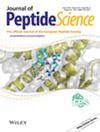硅辅助固相肽合成(SiPPS)
IF 1.8
4区 生物学
Q4 BIOCHEMISTRY & MOLECULAR BIOLOGY
引用次数: 0
摘要
无膨胀硅基树脂用于多肽合成。所使用的策略类似于固相肽合成(SPPS),称为硅辅助固相肽合成(SiPPS)。与1-h标准耦合相比,2-h耦合似乎更有利于耦合。使用这种不膨胀树脂可以减少50%的溶剂消耗。该策略在硅基载体(硅循环公司生产的Fmoc-Rink amide SiliaBond)的H-YSSFL-NH2、线性催产素、血管紧张素II和afamelanotide的合成中得到了很好的证明。这些肽被发现具有比可接受的纯度更高的纯度,尽管总体产量有所下降。本文章由计算机程序翻译,如有差异,请以英文原文为准。

Silica-Assisted Solid-Phase Peptide Synthesis (SiPPS)
Non-swelling silica-based resin was used for peptide synthesis. The strategy used is similar to that of solid-phase peptide synthesis (SPPS), referred to as silica-assisted solid-phase peptide synthesis (SiPPS). A 2-h coupling seemed to favor the coupling compared to that of 1-h standard coupling. The use of this non-swelling resin allows a 50% reduction in the consumption of solvents. The strategy was well demonstrated for the synthesis of H-YSSFL-NH2, linear oxytocin, angiotensin II, and afamelanotide using a silica-based support (Fmoc-Rink amide SiliaBond manufactured from SiliCycle Inc.). The peptides were found to have more than acceptable purity, although there was a loss in overall yields.
求助全文
通过发布文献求助,成功后即可免费获取论文全文。
去求助
来源期刊

Journal of Peptide Science
生物-分析化学
CiteScore
3.40
自引率
4.80%
发文量
83
审稿时长
1.7 months
期刊介绍:
The official Journal of the European Peptide Society EPS
The Journal of Peptide Science is a cooperative venture of John Wiley & Sons, Ltd and the European Peptide Society, undertaken for the advancement of international peptide science by the publication of original research results and reviews. The Journal of Peptide Science publishes three types of articles: Research Articles, Rapid Communications and Reviews.
The scope of the Journal embraces the whole range of peptide chemistry and biology: the isolation, characterisation, synthesis properties (chemical, physical, conformational, pharmacological, endocrine and immunological) and applications of natural peptides; studies of their analogues, including peptidomimetics; peptide antibiotics and other peptide-derived complex natural products; peptide and peptide-related drug design and development; peptide materials and nanomaterials science; combinatorial peptide research; the chemical synthesis of proteins; and methodological advances in all these areas. The spectrum of interests is well illustrated by the published proceedings of the regular international Symposia of the European, American, Japanese, Australian, Chinese and Indian Peptide Societies.
 求助内容:
求助内容: 应助结果提醒方式:
应助结果提醒方式:


